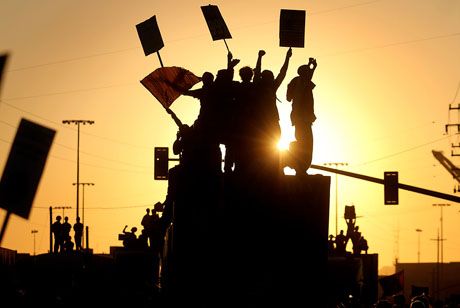Features
You are here
The Royal Commission on Aboriginal Peoples: 15 years on

November 23, 2011
It is now 15 years since the release of the report by the Royal Commission on Aboriginal Peoples (RCAP). The Commission was established in 1991 in the wake of at least two key events: the so-called “Oka Crisis” and the failure of the Meech Lake Accord.
The first event, the confrontation in Oka, Quebec in 1990 lasted 78 days, and saw the resistance of the Kanehsatake Mohawk people to encroachments on their territory proposed by the town of Oka, encroachments intended for a golf course. This struggle culminated in a stand-off with the Sûreté du Québec (the Quebec police), the RCMP and the Canadian Army. (This history has been brilliantly captured in a number of documentaries, including one produced by the National Film Board entitled Kanehsatake: 270 years of Resistance by filmmaker Alanis Obomsawin.)
During the same period, the 1987 Meech Lake Accord was under review for ratification by Quebec and the provinces. It represented an attempt by the Canadian state to have the people of Quebec accept the Canadian Constitution by formally recognizing Quebec as one of Canada’s founding nations. Aboriginal people understandably objected to their exclusion from this formulation and also feared that, through increased provincial powers, there would be even further limits on future First Nations lands claims. In 1992, through a parliamentary move in the Manitoba legislature by First Nations MLA Elijah Harper, Aboriginal people succeeded in stopping the signing of the Meech Lake Accord.
So, through militant action on the ground and in the legislature, Aboriginal people had put their concerns on the political map in ways not seen since the heyday of the Red Power movement in the early 1970s. It was within the context of this political pressure that the Canadian government established RCAP in 1991.
The RCAP process
The Commission was chaired by Georges Erasmus (a member of the Dene Nation and former head of the Assembly of First Nations) and René Dussault (a Quebec lawyer now with the law firm of Heenan Blaikie, where Pierre Trudeau and others of the ruling class have historically been partners). In total, there were four Aboriginal and three non-Aboriginal commissioners. They toured Canada and Quebec and held 178 public hearings, visited 96 communities, consulted individuals and reviewed relevant literature and past inquiries.
In many ways, the commissioners did not pull their punches. While the final report is 4,000 pages long, there is a much more accessible document published by RCAP entitled “People to People, Nation to Nation.” Within its opening pages can be found the following statements:
“There can be no peace or harmony unless there is justice …. Successive governments have tried – sometimes intentionally, sometimes in ignorance – to absorb Aboriginal people into Canadian society, thus eliminating them as distinct peoples. Policies pursued over the decades have undermined – and almost erased – Aboriginal cultures and identities. This is assimilation. It is a denial of the principles of peace, harmony and justice for which this country stands – and it has failed. Aboriginal peoples remain proudly different… Only as restored nations can they reach their potential in the twenty-first century.”
The report’s recommendations
The full report is a five-volume 4,000 page document and contains 440 recommendations covering all the key aspects of the lives of Aboriginal people. Each volume contains a theme. Volume 1, “Looking Forward, Looking Back,” has a focus on the historical relationship between indigenous peoples of Canada and Quebec, and settlers. The other volumes review modern, horrific living conditions and provide a range of optional responses, within a 20-year agenda to close the socioeconomic gap between Aboriginal and non-Aboriginal people, and to recognize Aboriginal peoples as self-governing nations with a unique place in Canada. Recommendations were made to both the Canadian government and First Nations.
Key recommendations include governance – a new Royal Proclamation to establish a new Nation-to-Nation relationship, recognition of Métis self-government, and the creation of an Aboriginal parliament. There are also legislative recommendations including the termination of the Indian Act and the Department of Indian Affairs (currently known as Aboriginal Affairs and Northern Development Canada), and the creation of a new department to implement the new Nation-to-Nation relationship, and a second department to provide services for non-self-governing communities (e.g. in urban areas, where an increasing proportion of Aboriginal people live).
Other recommendations call for a public inquiry into residential school abuse, the fulfillment of existing treaties and a new framework for negotiating new treaties, recognition of the Aboriginal right to self-determination, provision of land sufficient to foster Aboriginal economic self-reliance and cultural and political autonomy, improved Aboriginal access to resource-based economies, financing of Aboriginal economic development, a 10-year initiative to employ and train Aboriginal people, authority and resources to Aboriginal communities for child welfare, a framework for Aboriginal delivery of health and social services, a commitment to train 10,000 Aboriginal people over a 10-year period in health and social services, protection of traditional healing practices, resources to upgrade water and sewage systems, development of Aboriginally controlled education systems from early education to post-secondary, and many more.
The recommendations are sweeping in their scope. None of them would have come to public attention – in fact, the commission would never have happened – without a preceding history of militant resistance by Canada’s indigenous people.
The question is, fifteen years on: have any of these recommendations been implemented? That will be the topic of our next article in this series.
The National Film Board video documenting the Oka crisis, Kanehsatake: 270 years of Resistance by filmmaker Alanis Obomsawin, can be purchased at http://www.nfb.ca
Section:
Topics:
- Log in to post comments










